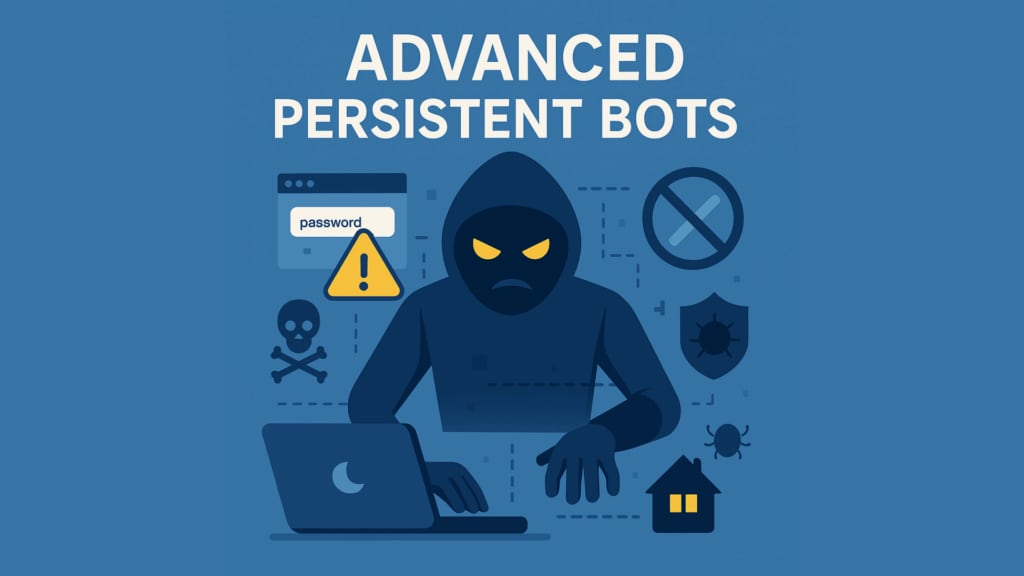
The internet is becoming an increasingly automated space, where bots play a central role in everything from indexing websites to automating mundane tasks. However, not all bots are benign. Among the most dangerous are Advanced Persistent Bots (APBs), which are designed to exploit vulnerabilities in your website’s security. These bots are not only difficult to detect but also continuously adapt to bypass protective measures, making them a serious and growing threat to businesses and online platforms.
Table of contents
- What Are Advanced Persistent Bots (APBs)?
- Dangers of APBs: Key Threats and Consequences
- Why Are Some Websites More Vulnerable to APBs?
- How Do Residential Proxies Enable APBs to Evade Detection?
- Sophistication of Bots: Basic, Intermediate, and Advanced Attacks
- Credential Stuffing and Bot Mitigation
- How Advanced Persistent Bots Impact Different Industries
- Protecting Your Website from APBs
- Conclusion
What Are Advanced Persistent Bots (APBs)?
APBs differ from simpler bots by their remarkable ability to mimic human behavior. They can perform actions such as loading external resources, manipulating cookies, and automating browser interactions — all in an effort to bypass common security systems like CAPTCHAs. What sets them apart is their persistence: APBs don’t just strike once and disappear—they continue to evolve and find new ways to sneak through defenses.
These bots use dynamic IP rotation and tools like Tor networks and peer-to-peer proxies to conceal their identity. This constant adaptation, along with rotating IPs and using residential proxies, makes APBs hard to detect with traditional security measures.
Dangers of APBs: Key Threats and Consequences
Advanced Persistent Bots are responsible for a wide range of harmful activities that can damage a website’s integrity and business operations. These threats often go unnoticed for extended periods, allowing APBs to cause long-term harm. Some common threats posed by APBs include data scraping, brute-force attacks, and credential stuffing. These bots are designed to steal valuable data, hack accounts, and infiltrate systems by using stolen credentials.
In e-commerce, APBs often cause inventory hoarding or automated purchasing, resulting in stock shortages or inflated prices. APBs can also be used to generate fraudulent clicks on digital ads, wasting marketing budgets and disrupting digital campaigns.
Why Are Some Websites More Vulnerable to APBs?
Certain websites and industries are particularly susceptible to attacks from APBs. Medium-sized websites (ranked between 10,000 and 50,000 on Alexa) often face more bot traffic. Their visibility attracts attacks, but they lack the advanced security systems to defend against them.
Digital publishers, e-commerce platforms, and industries such as hospitality and entertainment are especially vulnerable. These sectors experience a significant percentage of their traffic from bots, which can disrupt operations, steal intellectual property, or manipulate supply chains.
How Do Residential Proxies Enable APBs to Evade Detection?
A major challenge in bot detection is the increasing use of residential proxies by bot operators. These proxies reroute bot traffic through private residential IP addresses, making the traffic appear to be from legitimate users. Since these IP addresses are linked to real users, traditional IP-based blocking methods fail against APBs using this technique.
4o mini. This makes the detection and mitigation of these bots even more challenging.
Sophistication of Bots: Basic, Intermediate, and Advanced Attacks
The level of sophistication varies among bots. Most attacks on websites are carried out by basic bots, which use simple tactics like web scraping. However, attacks on mobile APIs often come from intermediate bots, which exhibit more refined behaviors to evade detection. The most advanced bots typically target highly competitive sectors such as general retail, banking, and airlines, and they employ advanced evasion tactics such as using residential proxies to disguise their identity.
Rating systems on websites are prime targets for sophisticated bots using techniques like generative AI to manipulate reviews. This demonstrates how advanced bot technology has become, making simple CAPTCHA solutions insufficient to defend against evolving threats.
Credential Stuffing and Bot Mitigation
Credential stuffing remains a significant threat, with bots trying stolen username-password combinations across multiple websites. Industries such as e-commerce, gaming, and technology are particularly targeted by credential stuffing attacks. Interestingly, bot activity in mobile APIs shows a different pattern. While bots targeting websites often rely on simple credential stuffing, attacks on mobile APIs tend to be more advanced, especially in sectors like telecommunications.
After activating bot mitigation strategies, bot activity may initially rise as operators adjust their methods. However, with proper mitigation, these attacks can be neutralized without disrupting the user experience. This highlights the need for evolving defense mechanisms.
How Advanced Persistent Bots Impact Different Industries
Advanced Persistent Bots (APBs) don’t target all websites equally. Certain industries and platforms are particularly vulnerable to these sophisticated threats. For example, the hotel and hospitality sector experienced nearly 45% of its web traffic from unauthorized bots, primarily due to web scraping. Similarly, the entertainment industry faced the most significant bot traffic (23%) on mobile APIs. Understanding these patterns is crucial for tailoring security measures to the specific risks of your industry.
Bot behavior varies by platform. Web traffic attacks are more prone to scraping and reseller bots, while mobile API attacks are more sophisticated. Advanced bots commonly target sectors like general retail, airlines, and banking, using credential stuffing to exploit compromised data. In contrast, telecommunications and entertainment industries face sophisticated bot activity in mobile APIs, making them especially vulnerable to automated attacks.
Protecting Your Website from APBs
Given the growing sophistication of APBs, it’s crucial to implement advanced security measures to defend against them. Here are some strategies for protecting your website:
Web Application Firewalls (WAFs) with integrated bot protection are essential in detecting and blocking automated traffic in real time. They are using machine learning and pattern recognition to spot suspicious activity. Additionally, leveraging machine learning can enhance your ability to identify bot-like behavior. These AI-driven systems learn from data patterns, enabling them to detect even the most human-like bot activities and stop them in their tracks.
Another critical measure is the use of invisible CAPTCHA, which runs in the background and doesn’t interrupt the user experience. This CAPTCHA solution detects suspicious behavior without requiring user interaction. For a more advanced layer of defense, you can implement behavioral biometrics, which analyzes how users interact with your website. By examining factors like typing speed and mouse movements, these systems can spot anomalies that indicate bot activity, even if the bot is trying to replicate human behavior.
Conclusion
Advanced Persistent Bots represent a growing challenge in website security. Their ability to mimic human behavior and continuously evolve makes them a persistent threat to businesses and online platforms. However, by implementing advanced security measures like AI-powered CAPTCHA, invisible CAPTCHA, and machine learning-based detection, you can protect your website from these evolving threats.
For a privacy-compliant and user-friendly CAPTCHA solution, captcha.eu is the ideal choice to protect your website from Advanced Persistent Bots and other types of automated threats. Our solution utilizes cutting-edge technology, including AI-driven detection systems and invisible CAPTCHA methods, to offer seamless security without interrupting the user experience. Captcha.eu ensures your site is protected from the most sophisticated bots while remaining compliant with GDPR and other data privacy regulations.
100 free requests
You have the opportunity to test and try our product with 100 free requests.
If you have any questions
Contact us
Our support team is available to assist you.




